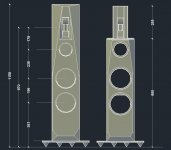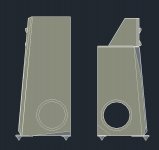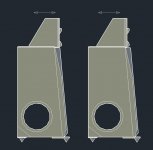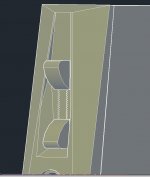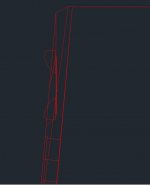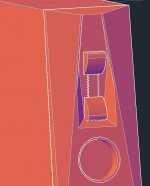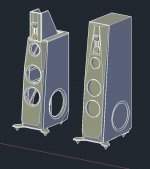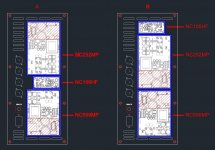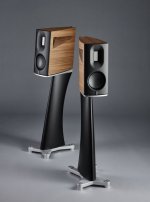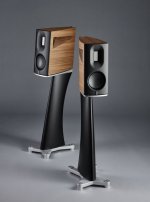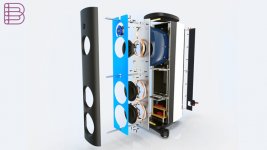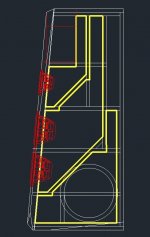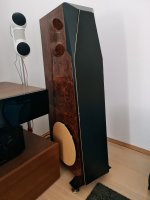Hi all
I know, I know this mide be way out of league but I'm gonna build it anyway
I'm not an expert in any way, but I have make couple speakers and they did sound nice to me.
Now as time goes by, I'm starting to lose interest in diy so this will probably be my last diy project...At least I hope as one is more expensive than the previous one
In a couple days I will start making test cabinets but would like, if someone has time to check my plans about volume for drivers and spacing between those. I would appreciate it.
Below you will find pictures of concept design.
One is a classic box, and the other is a box with tweeter on top to have the option for sliding it forward and back for time alignment (not important as I have DSP..but it look's cool to me .
.
Front baffle is at 5* angle but tweeter is not angled.
At first I liked the option with tweeter on top, but leter I prefer a more classical design...will see....
Thas will be fully active, analog precision DSP, hypex, SB acoustics with RAAL drivers, all in closed boxes ;
- 2 X Satori textreme MW19TX-8 + second channel of NC252MP / satori-mw19tx-8-textreme
in a like 9 litres per driver, total around 18-20L closed box
- 2 X SBA subwoofers SW26DBAC76-8 / sw26dbac76-8
dual oposite subwoofers in like 20 litres closed box with linkwitz transform (like 9-10 litres per driver)
Crossover points would bi like ;
Baffle wide is 220 mm.
What do you think ?
What about driver spacing between drivers in dependence of crossover frequencies ?
RAAL advise me to place center of tweeter at around 95 cm.
And one question how to place all those amplifiers on a plate.
Option A when I have power supply of NC252 and NC500 facing to the top and bottom of plate - speaker cables will cross each other
Option B when I have NC252 and NC500 power supply facing each other - the interconnection cable for subwoofers will be a little longer run by the power supply. Don't know if there will be any interference.
For me option A looks like a safer bet, but option B would be easier to connect once they are inside the cabinet...or not...
Please don't be hard on me, I'm not an expert, and I'm doing my best to not become one
Will play with baffle design around tweeter, to achieve something like wave guide or not...will play and will se where it will take me...
The look is like 90% of the sound so , it's more important how it looks then the sound of it
, it's more important how it looks then the sound of it 
Here is a video of my previous build, so I'm not total noob, but... VIDEO 1 or VIDEO 2
I know, I know this mide be way out of league but I'm gonna build it anyway
I'm not an expert in any way, but I have make couple speakers and they did sound nice to me.
Now as time goes by, I'm starting to lose interest in diy so this will probably be my last diy project...At least I hope as one is more expensive than the previous one
In a couple days I will start making test cabinets but would like, if someone has time to check my plans about volume for drivers and spacing between those. I would appreciate it.
Below you will find pictures of concept design.
One is a classic box, and the other is a box with tweeter on top to have the option for sliding it forward and back for time alignment (not important as I have DSP..but it look's cool to me
Front baffle is at 5* angle but tweeter is not angled.
At first I liked the option with tweeter on top, but leter I prefer a more classical design...will see....
Thas will be fully active, analog precision DSP, hypex, SB acoustics with RAAL drivers, all in closed boxes ;
- analog precision 8 chanel DSP
- RAAL 140-15D AM + hypex NC100HF - connected to NC252MP / RAAL_140-15D
- Satori textreme MW13TX-8 + one channel of NC252MP / satori-mw13tx-8-textreme
- 2 X Satori textreme MW19TX-8 + second channel of NC252MP / satori-mw19tx-8-textreme
in a like 9 litres per driver, total around 18-20L closed box
- 2 X SBA subwoofers SW26DBAC76-8 / sw26dbac76-8
dual oposite subwoofers in like 20 litres closed box with linkwitz transform (like 9-10 litres per driver)
Crossover points would bi like ;
- sub / 19TX - around 80-85Hz
- 19TX / 13TX - around 500-600Hz ( at about baffle diffraction point ?)
- 13TX / RAAL - from 1.7-2.4kHz will see what sound best
Baffle wide is 220 mm.
What do you think ?
What about driver spacing between drivers in dependence of crossover frequencies ?
RAAL advise me to place center of tweeter at around 95 cm.
And one question how to place all those amplifiers on a plate.
Option A when I have power supply of NC252 and NC500 facing to the top and bottom of plate - speaker cables will cross each other
Option B when I have NC252 and NC500 power supply facing each other - the interconnection cable for subwoofers will be a little longer run by the power supply. Don't know if there will be any interference.
For me option A looks like a safer bet, but option B would be easier to connect once they are inside the cabinet...or not...
Please don't be hard on me, I'm not an expert, and I'm doing my best to not become one
Will play with baffle design around tweeter, to achieve something like wave guide or not...will play and will se where it will take me...
The look is like 90% of the sound so
Here is a video of my previous build, so I'm not total noob, but... VIDEO 1 or VIDEO 2
Attachments
Most of the design is conventional. With a DSP + measurement equipment, the chance of ending up with a good sounding loudspeaker is high. I would worry about diffraction on image 4, 5, 6, 10 though. A tweeter should be flush with the baffle if it has no waveguide. Change that and you are good to go. If you want a waveguide, it should start at the ribbon itself and not at the edges of its face plate.
If costs are a concern, you can cut costs by picking cheaper components. I would like to stress that most of the performance lies in the design, not in the price of the components. You can design the loudspeaker such that the drivers do not operate under conditions which otherwise shows their deficiencies. The Kii Audio Three is a great example of that. It has a dirt cheap midrange driver (apparently € 13), which is fine because the frequency response is hammered into shape with the DSP, excursion-related non-linearities are irrelevant for a midrange driver and current-related non-linearities are fixed with current drive.
If costs are a concern, you can cut costs by picking cheaper components. I would like to stress that most of the performance lies in the design, not in the price of the components. You can design the loudspeaker such that the drivers do not operate under conditions which otherwise shows their deficiencies. The Kii Audio Three is a great example of that. It has a dirt cheap midrange driver (apparently € 13), which is fine because the frequency response is hammered into shape with the DSP, excursion-related non-linearities are irrelevant for a midrange driver and current-related non-linearities are fixed with current drive.
Last edited:
Thanks TBTL
I have all the drivers and amplifiers so I'm not worried about the costs ...or it's too late for that
...or it's too late for that 
I know what you mean about defraction around tweeters but I see couple spekaer designs with ribon drivers where they use something like 45* round ower tweeters. Like small wave guide. Will try to make some test baffle and measure results.
Something like borresen
I have all the drivers and amplifiers so I'm not worried about the costs
I know what you mean about defraction around tweeters but I see couple spekaer designs with ribon drivers where they use something like 45* round ower tweeters. Like small wave guide. Will try to make some test baffle and measure results.
Something like borresen
Attachments
Last edited:
It is hit and miss to just make 45 angle throat/WG for the tweeter. Most likely not working well.
different with woofers. Many High costs speaker have drivers mounted from the back of the speaker. It is not only for good looks. Though tad difficult to implement with the satori drivers because of the non flat chassis.
I would think enclosure size is on the Small size. Yes you can do tricks with LT, but it is no free lounch. Ie higher Distortion. If it Sounds good you can test.
also with closed volume for midrange. Good Old advise is making it bigger than you need for improved midrange.
different with woofers. Many High costs speaker have drivers mounted from the back of the speaker. It is not only for good looks. Though tad difficult to implement with the satori drivers because of the non flat chassis.
I would think enclosure size is on the Small size. Yes you can do tricks with LT, but it is no free lounch. Ie higher Distortion. If it Sounds good you can test.
also with closed volume for midrange. Good Old advise is making it bigger than you need for improved midrange.
I don't know how those speakers are made... but it does not look like the rear panel is removable, in fact it does not look like there IS a rear panel.
So I would guess that the drivers are mounted to a flat baffle that is hidden, and then the highly profiled front baffle is laid on top, perhaps held in place with magnets.
So I would guess that the drivers are mounted to a flat baffle that is hidden, and then the highly profiled front baffle is laid on top, perhaps held in place with magnets.
It is hit and miss to just make 45 angle throat/WG for the tweeter. Most likely not working well.
different with woofers. Many High costs speaker have drivers mounted from the back of the speaker. It is not only for good looks. Though tad difficult to implement with the satori drivers because of the non flat chassis.
I would think enclosure size is on the Small size. Yes you can do tricks with LT, but it is no free lounch. Ie higher Distortion. If it Sounds good you can test.
also with closed volume for midrange. Good Old advise is making it bigger than you need for improved midrange.
Thanks Rokytheman
Yes, enclosure is on the smaller size, as I have small apartment so I have to squeeze everything.
I can add some volume for midrange driver (13TX) to get like 5 litres. Don't know will more will have any advantage ?
And I was thinking that filling cabinets with damping material would increase volume that driver see. So I presume I will be good.
Someone from SBA advise me to use lover volume for 19TX to get more ''pronounce'' bass. Maybe I'm wrong.
Volume of 9-11 litres per driver would give me F3 of around 80Hz with a little higher Qtc , something like 0.8 if I'm not mistaken.
Apparently it is ok for bass drivers ?
And if I fill cabinet with damping material I will ''lower'' the Qtc to something like 0.7 or less any way ?
I have to say that I did have loudspeakers with Qtc of 0.5 and did not like it. (0.7 was better for my taste)
About LT on subwoofers, I think that higher distortion would not be that much a problem for bass notes from 20-80Hz ?
But I don't play music on high levels. Again I hope I'm on good side.
Whell the thing is, if I'm gonna with more volume my boxes are will become to big for my apartment
Will play with baffle around tweeter to see what I will get.
Last edited:
I don't know how those speakers are made... but it does not look like the rear panel is removable, in fact it does not look like there IS a rear panel.
So I would guess that the drivers are mounted to a flat baffle that is hidden, and then the highly profiled front baffle is laid on top, perhaps held in place with magnets.
Jea, I cant see it ether.
As Rokytheman mention, satori have non flat front chassis, so it will be a little problem to mount.
I would have to cnc the front and the back of baffle to make it work.
Don't know if magnets (neodymium) are strong enough to keep everything in place and prevent everything from resonating.
or to use rod bars from the back to front as Magico
Go have a look at Magico speakers. Many of them should give you some ideas for double baffle applications, driver mounting and driver isolation techniques.
Jea, I see some of their solution with bars from the back to front, with damping material (light blue on the picture) in be twin ?
any idea what to use in place for light blue material ?
It is an option...will think about it
Attachments
@yoke:
I think long quotes are against rulew so I try answer like this:
Midrange cabinet:
Difficult to say. I think Troels Gravesen made cabinet with paperversion in like 5-6 liters. They Way i see it, the bigger the cabinet, the less restriction for the cone to move = May yield better midrange.
Woofer cabinet:
If Qtc is 0,8 yes a little extra bass than ie 0,7. If SBA advised believe they are true. Also some diy’ers seems to have luck in relative Small volume for ‘kicker driver’
Damping:
My preference is thick felt (9-10 mm stuff) then pure wool. The same stuff Gravesen uses. Though I would open it more than he does ie. as fluffy as possible. In Old does cabinet were totally stuffed with fiberwool/Rockwool. I find it kills dynamic. Morale is that stuffing through testing is always worth doing. Very little change of material can make a big difference.
for sub-bass we have different situation. I would still use some felt, but more rigid material is better, if you have standing waves. Else nothing is needed. But test will tell.
I think long quotes are against rulew so I try answer like this:
Midrange cabinet:
Difficult to say. I think Troels Gravesen made cabinet with paperversion in like 5-6 liters. They Way i see it, the bigger the cabinet, the less restriction for the cone to move = May yield better midrange.
Woofer cabinet:
If Qtc is 0,8 yes a little extra bass than ie 0,7. If SBA advised believe they are true. Also some diy’ers seems to have luck in relative Small volume for ‘kicker driver’
Damping:
My preference is thick felt (9-10 mm stuff) then pure wool. The same stuff Gravesen uses. Though I would open it more than he does ie. as fluffy as possible. In Old does cabinet were totally stuffed with fiberwool/Rockwool. I find it kills dynamic. Morale is that stuffing through testing is always worth doing. Very little change of material can make a big difference.
for sub-bass we have different situation. I would still use some felt, but more rigid material is better, if you have standing waves. Else nothing is needed. But test will tell.
The only thing that might need DSP is the sub.
I have that RAAL 140-15D AM tweeter. In order to get it down to 1700Hz, I needed a 25cm deep horn:
They are for sale, btw. I made two identical horns for the Raal. €100 + shipping. 

RAAL 140-15D AM in the wooden horns.
It was much better with a horn, but next time I will use a much smaller one and cross it muuch higher.
Right now I use the Faitalpro HF10AK which does go high enough but not as smooth:
I have that RAAL 140-15D AM tweeter. In order to get it down to 1700Hz, I needed a 25cm deep horn:
RAAL 140-15D AM in the wooden horns.
It was much better with a horn, but next time I will use a much smaller one and cross it muuch higher.
Right now I use the Faitalpro HF10AK which does go high enough but not as smooth:
Last edited:
I actually heard some of the shallow subwoofers like you have in small cabinet. Impressive for the size!
Difficult to say whether a bigger cabinet actually sound better in practices - I think it is pushing limits lowering Fb more than 15 hz. Haven’t calculated but guess you need like +15 dB in the Hypex to get Fb down to like 35 hz?
Damping between baffles
I can recommend pure cork sheets in 4 mm thickness. Very easy to cut and sand. Also to mingle in to shape. It has some damping properties and also complete airtight. I like it because I don’t need to glue it and also easy to dismantle because of no glue haha.
I expect cork to last a loooong time.
Difficult to say whether a bigger cabinet actually sound better in practices - I think it is pushing limits lowering Fb more than 15 hz. Haven’t calculated but guess you need like +15 dB in the Hypex to get Fb down to like 35 hz?
Damping between baffles
I can recommend pure cork sheets in 4 mm thickness. Very easy to cut and sand. Also to mingle in to shape. It has some damping properties and also complete airtight. I like it because I don’t need to glue it and also easy to dismantle because of no glue haha.
I expect cork to last a loooong time.
Last edited:
Wondering if Magico used blue gas can for that midrange…..
Different way of doing it, could be an adaptor ring? I made mine with neo magnets, then protruding screws. Took some time to cut, but I find it work well. I prefer to design my speakers with grill, because I think it improves aesthetics and also how I focus when listening to music. Critics would argue we have some extra diffractions and we have. But one could design grill so it is not that bad.


Different way of doing it, could be an adaptor ring? I made mine with neo magnets, then protruding screws. Took some time to cut, but I find it work well. I prefer to design my speakers with grill, because I think it improves aesthetics and also how I focus when listening to music. Critics would argue we have some extra diffractions and we have. But one could design grill so it is not that bad.
Midrange cabinet:
...
Woofer cabinet:
...
Damping:
...
I have space for 5L on midrange so will try it, 22L for 2X19 and 20L for 2XSW.
I havent use felt on sides of cabinet. I usually just use Sonofil - High-construction polyester fleece in combination with natural wool.
Oldo I'm still not shure how to use natural wool. But will experiment more.
As you say, if I place too much damping material it does ''kill'' the sound, and I try to leave some free space behind drivers for ''breading''.
I actually heard some of the shallow subwoofers like you have in small cabinet. Impressive for the size!
Difficult to say whether a bigger cabinet actually sound better in practices - I think it is pushing limits lowering Fb more than 15 hz. Haven’t calculated but guess you need like +15 dB in the Hypex to get Fb down to like 35 hz?
Damping between baffles
LT is just about that +15db but on 15Hz ( I will place lower limiter, so it will not go that low), and little less for 20 (like +13 or even less) for 10L
The lower volume the more +db would have to be applied but nothing dramatic. For 9L it would be like +17db on 15Hz, any way, less then +15 for 20Hz.
So I'm on safe side
About front baffle I have to think. Should I use rods form the back or add additional rings for the look (as you did).
I don't use textile grills as they don't help when you have cats.
They have destroy like 3 of my drivers in the past, the ruber suspension, and now I use peace of 3mm MDF with magnets, to cover whole front side when I don't listen music
This doesn't look nice, will make better looking one, but it do the trick.
Attachments
The only thing that might need DSP is the sub.
I have that RAAL 140-15D AM tweeter. In order to get it down to 1700Hz, I needed a 25cm deep horn: They are for sale, btw. I made two identical horns for the Raal. €100 + shipping.
Jea...that thing about DSP correction mide bi right
As I'm not and expert I'm looking for the drivers that are ''easy'' to work with.
That's why I chose those.
Thay are expensive but, I have no real knowledge as people behind Kii, so this is the road I chose
Thank you for the offer about WG for RAAL. To me, for my purpose they look a little to big. And I presume that RAAL don't have to go that low as I have 13 in place. Am thinking that I really don't need WG in first place.
But will do some experiments and will se how it goes.
I have used RAAL 140-15D in the past and I really like the sound of it, but I sold it like 10 years ago.
In my memory it was best tweeter I have heard.
I like SATORI BE, but for this project I wonted to try RAAL once more.
Wondering if Magico used blue gas can for that midrange…..
I think they do, plus it looks like it have two layers (outer blue and inner lighter blue) and damping/absorption material in be twin ?.
It looks like half an egg, nice round surface.
What kind of analog precision 8 chanel DSP are you using?
I have first generation with ES9028PRO
https://www.diyaudio.com/community/...tegrated-preamp-crossover-dac-project.264743/
https://www.facebook.com/AnalogPrecision/
The wab page show me some error...I belive it's just a temperal down
https://analog-precision.com/
Re the Magico baffle system:
- I suspect that what Magico used for damping in between the 2 baffles is outside of my price range, so I used sorbithane instead when I tried to copy it (1/8" 40 durometer). My research suggested that the most important aspect is for the material to retain its damping properties while under compression, something that not very many materials do well.
- Notice that the woofers and mid are attached to the first baffle and the tweeter to the second. I believe that the mid is also decoupled via another ring of the sorbithane-like material. In my implementation, I attached both the tweeter and the mid to the second baffle using sorbathane gaskets which I found easier and also gave my mid more breathing room in the back.
- Also note that the threaded rods achieve a secondary function of raising the frequency of any resonances of the baffles involved (and perhaps the connecting side walls too when they are curved like the older Magico Minis) because the baffles are under tension. Threaded rods can be a little tricky to implement well though, as you want to try to avoid having them touch the inner baffle which has got the woofers attached. Plus you need to figure out how to attach them to the outer baffle without being seen (ie. how to insert a nut of some kind into them) and how to make sure the rods won't screw through the outer surface when you tighten them up from the back.
- I suspect that what Magico used for damping in between the 2 baffles is outside of my price range, so I used sorbithane instead when I tried to copy it (1/8" 40 durometer). My research suggested that the most important aspect is for the material to retain its damping properties while under compression, something that not very many materials do well.
- Notice that the woofers and mid are attached to the first baffle and the tweeter to the second. I believe that the mid is also decoupled via another ring of the sorbithane-like material. In my implementation, I attached both the tweeter and the mid to the second baffle using sorbathane gaskets which I found easier and also gave my mid more breathing room in the back.
- Also note that the threaded rods achieve a secondary function of raising the frequency of any resonances of the baffles involved (and perhaps the connecting side walls too when they are curved like the older Magico Minis) because the baffles are under tension. Threaded rods can be a little tricky to implement well though, as you want to try to avoid having them touch the inner baffle which has got the woofers attached. Plus you need to figure out how to attach them to the outer baffle without being seen (ie. how to insert a nut of some kind into them) and how to make sure the rods won't screw through the outer surface when you tighten them up from the back.
- Home
- Loudspeakers
- Multi-Way
- 3.5/4 way loudspeakers insanity check
